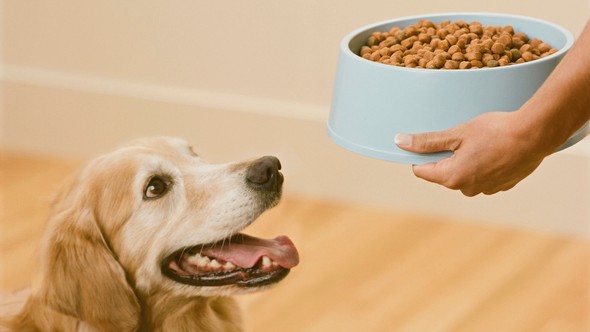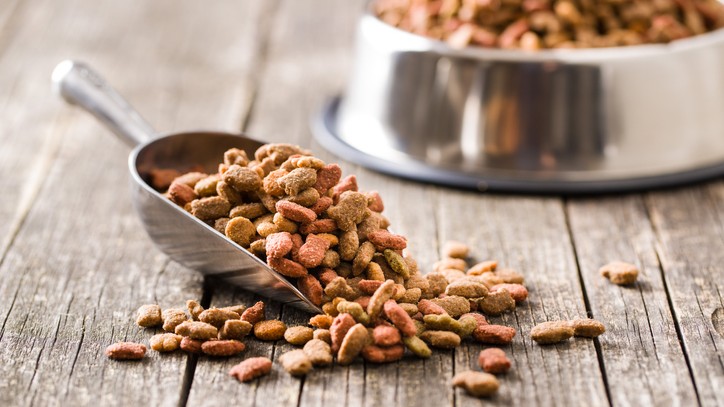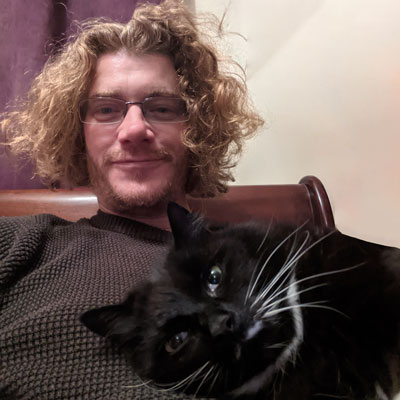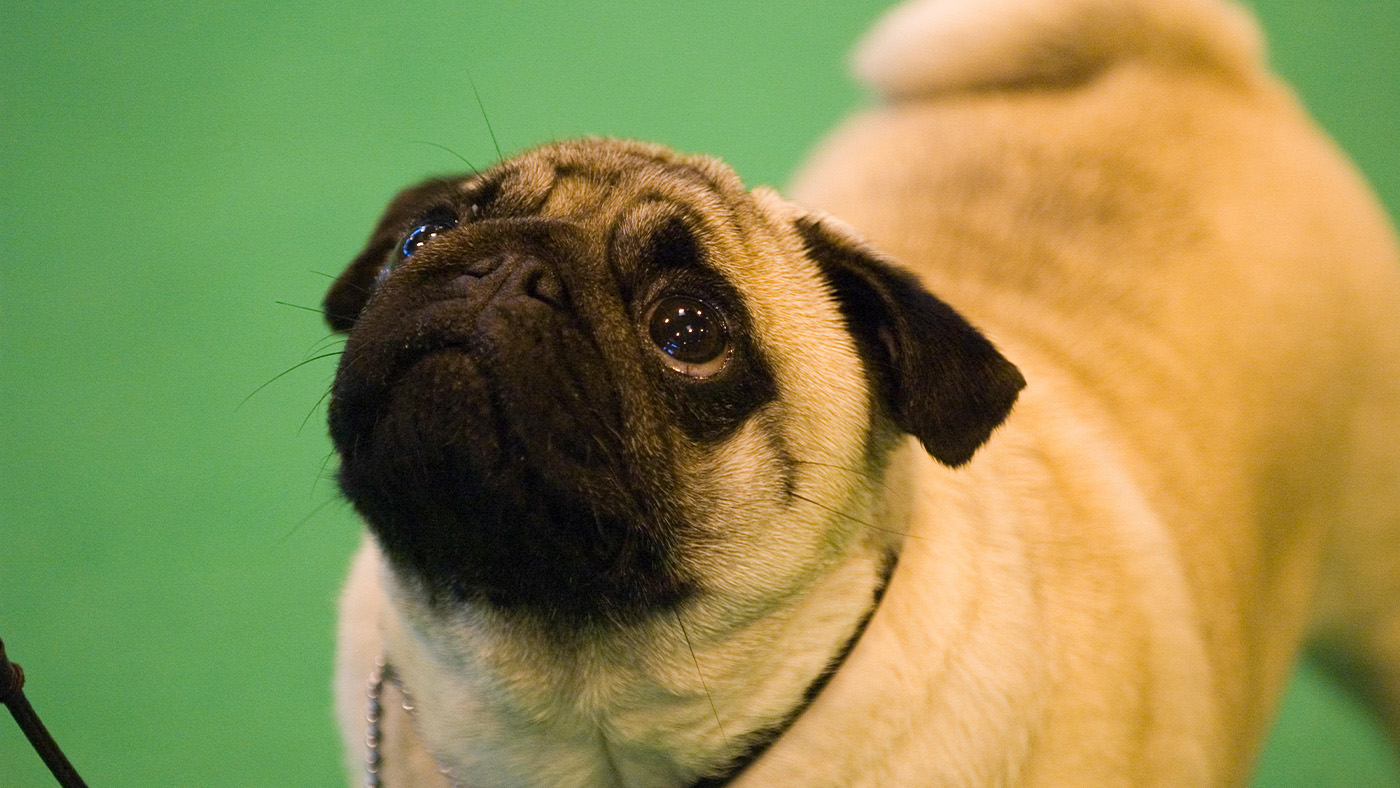What's in kibble and why do animals find it so tasty?
We examine what’s in kibble and the food science behind the dry pet foods your furry friends crave

Here's our quick guide to what’s in kibble, why your pets love it so much, the fillers to watch out for, and the ingredients needed to ensure your beloved pets stay healthy.
The debate about whether dry vs wet food is better for your cat or dog is one that has been rumbling along for years. There have been huge improvements in understanding animal nutrition since the start of the pet food boom in the 1960s. This research has helped inform the ingredient choice used in kibble recipes, meaning they are getting healthier for pet owners to use. This is a useful development, as pet food owners often choose kibble over wet food because of benefits like its long storage life and less offensive smell, while still offering something finicky pets will enjoy. With 90% of Americans using it to feed their pets, we thought it was worth finding out exactly what is in kibble.
- Best dog food: deliver a delicious doggy diet to your pet pooch
- Best dry cat food: The most nutritious meals for your feline friend
- Best dry dog food: Fuel your furkid with the finest kibble
What's in kibble?
Kibble is made up of ground-up ingredients shaped into pellets and dried. This can include meat, grains, vegetables, and carbohydrate fillers. Typically, for meat eaters, as well as the carbohydrate base, it will include assorted protein and fats, fiber, preservatives like antioxidants (to stop the fats going rancid), emulsifiers (to stop the fat separating out of the food), as well as vitamins, minerals, probiotics, and digestibility enhancers. There are usually also additives included like anti-parasitic compounds and minerals designed to keep your pet's teeth clean. Hopefully this will make you a lot more confident about what's in kibble.
How is kibble made?
While 'what's in kibble' is an important question, perhaps as important is how it's made. Whether it's supermarket own-brand or premium, grain-free or organic, all kibbles are made by the same expansion and extrusion process, very similar to how puffed corn snacks are made for humans. All the ingredients are mixed up into a paste, which is then cooked using hot water or steam applied at extremely high temperatures and pressures. The resulting dough is then pushed through tubes or a plate with holes in to give the pellets their final shape.
These pellets are then dried to remove any remaining water (and give the kibble that long shelf life) and are then coated with oils and flavorings that animals find irresistible, as well as vitamins to replace those lost in the cooking process. Mint and oregano are favorite additives for herbivores, and a range of meat-based chemicals and extracts are used for cats and dogs.
What's in kibble that attracts animals to it
The secret to making animals want to eat kibble is that tasty and strong-smelling coating rather than what's in kibble. Much like Cheetos and Doritos for humans, it's not the plain corn snack we crave, but the cheesy and spicy dust that coats them. That's not to say there isn't anything appetizing in the pellet itself; it's just nowhere near as irresistible smelling as what it is sprayed with.
A lot of the protein found in cat and dog kibble is in the form of hydrolyzed protein, which gives off an attractive smell to carnivores. To 'hydrolyze' a protein, you break down the long protein chains found in meat using enzymes or hydrochloric acid – it produces the same effect as cooking food for a long time. Although this is a smell humans can deal with happily and meat-eating animals find appetizing, to properly attract cats and dogs you need to add some truly revolting odors.
Most of the smells we humans find objectionable, like vomit, excrement and rotting flesh, are very appetizing to cats and dogs. We associate these smells with disease and illness, whereas to animals they just indicate where a potential food source can be found. In fact, the problem kibble manufacturers have is how to balance the smells they add to make them foul enough to attract cats and dogs, but tolerable enough that people will buy it without worrying about it stinking out their homes.
You only need to look at the names of the additives to get a clue as to how unpalatable humans can find them: putrescine and cadaverine. Both are colorless chemicals produced naturally by the breakdown of proteins that are largely responsible for the revolting smell of rotting flesh – and cats and dogs love them.
Cat kibble is also treated with pyrophosphates, commonly referred to in the industry as 'cat crack'. This chemical seems to intensify the flavor of amino acids found in proteins, and cats can't get enough of it.

How can I tell if what’s in kibble is safe?
In the US, Europe, and UK, there are reasonably strict rules on what can go in pet food. Anything designated as 'complete' will meet the nutritional standards needed to ensure it contains everything needed for your animal to be healthy.
In the United States, the Food and Drug Administration (FDA) regulates pet food products and their ingredients. Nearly all states also require pet food products to be registered, and for their labels to adhere to strict requirements regarding product names and ingredients. If you want to check a particular kibble ingredient, you can see a list of GRAS (Generally Recognized as Safe) ingredients on the FDA website.
In the UK, as long as the food meets PFMA (Pet Food Manufacturing Association) guidelines, it will have the complete nutritional requirements for pets. You can check on the PFMA website to find out whether your pet food brand's manufacturer is a member.
The best key as to the quality of kibbles for cats and dogs is the protein content. The higher the protein, the lower the carbohydrate filler. Because kibble is dried, you should always provide water, as well as food, when feeding your animals to prevent them getting dehydrated. Read dog food ingredients explained for more information.
Does what’s in kibble cause obesity in pets?
The short answer is no. No more than any delicious human food is the cause of obesity in humans – it's all about portion size. Pet food manufacturers argue that they have to make kibble as delicious as possible so that all of the portion is eaten to ensure that your pets nutritional needs are met. This means that it's up to you to ignore those pleading eyes begging you for more of this tasty food. If you make the effort to control how much food you are giving your pets (while ensuring they are exercised), then your furry friends will not get fat. Take a look at this article if you want to know what to do if your dog is overweight.
Worries about added sugar making your cat fatter is also not true. Cats can't even taste 'sweet' so adding extra sugar to cat kibble has no effect on how much a cat will eat. Their diet in the wild contains no carbohydrates so they have no need to detect the sweet taste of these sugars when searching for food. That's why cats will leave left out donuts and cakes alone.
Dogs, of course, really can taste sugar, and will snaffle confectionary whenever they can. This is because dogs have been eating scraps from humans for a lot longer, while cats were left to look after themselves as they were there to get rid of rodent pests. As dogs have evolved to taste (and crave) sugar, this is an ingredient you should check the quantity of when buying their kibble.
Some kibbles for carnivores are certainly of a lower nutritional quality than others. Watch out for those heavy on carbohydrates – you should choose those with a higher percentage of protein for your dog or cat.
Can what’s in kibble cause dehydration?
One of the main issues with kibble is the fact that it is made up of dried food. Cats and dogs are used to eating wet food – meat – in the wild, so are used to getting hydration from there. If your animal is on an only dry food diet then ensure there is always water available for them to hydrate themselves – a pet water fountain is a good way to encourage them to drink.
Is what’s in kibble addictive?
It's not so much addictive as too delicious! It is no surprise that animals crave food that we have specifically designed for them to like. Again, controlling portion size is the way to ensure that they aren't overeating and learning to ignore those begging stares and mournful miaows!
PetsRadar Newsletter
Get the best advice, tips and top tech for your beloved Pets
Jamie Middleton is a freelance editor and writer who has been editing and creating content for magazines and websites for over 20 years. As well as writing about the pets he loves, he has helped create websites about tech and innovation like TechRadar.com, Innovate UK and TechSPARK, written programmes for music festivals, books on inventions and architecture, TV listings magazines, and edited publications about cars such as Lexus, Toyota and Jaguar. In his spare time he writes fiction books and poetry - or at least he does when he is permitted to by his cat Pirate, who enjoys the warmth of laptops too much to allow being creative to get in the way.

